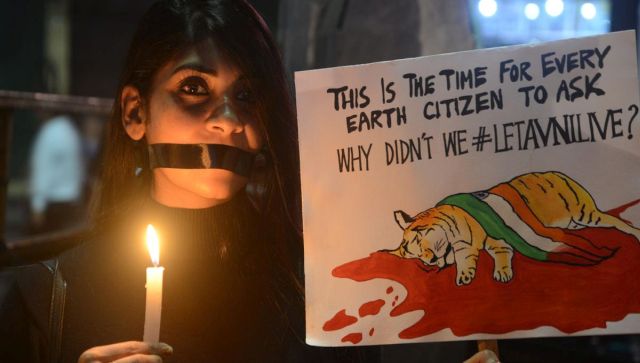The killing of ‘man-eater’ of Champaran, India’s controversial hunter, and the complexities of tiger conservation
The killing of ‘man-eater’ of Champaran, India’s controversial hunter, and the complexities of tiger conservation

India has lost one more tiger, declared a “man-eater” in Bihar’s Champaran. The tiger, T-104, in Valmiki Tiger Reserve (VTR) was shot dead on Saturday after it was declared a man-eater by the state forest department and blamed for six human deaths in a month.
Forest officials have said that the big cat claimed two lives on Saturday – Babita Devi, a widow, and her eight-year-old son CM Kumar. According to official records, nine people were allegedly killed by the animal since May and a 16-year-old was crippled after it attacked him. 
Shoot-at-sight orders
Following protests from villagers around VTR, the National Tiger Conservation Authority (NTCA) and the state’s additional principal chief conservator of forest-cum-wildlife warden issued shoot-at-sight orders against the male tiger on 7 October.
Also read: Why the big cat’s future in the country appears shaky
“An order has been issued to kill the tiger that has caused death to common life. The order has been issued by the department’s additional principal chief conservator of forest-cum-chief wildlife warden, Bihar Shri Prabhat Kumar Gupta in which it has been considered necessary to kill the tiger in view of all the circumstances,” said the government release.
Kumar Gupta, chief wildlife warden for the region, told The Times of India that the tiger had been identified as “dangerous to human lives”. According to him attempts to tranquilise T-104 were unsuccessful and it showed a “complete lack of fear” when surrounded by teams.
Bihar | Orders issued to kill ‘man-eating’ tiger that killed nine people in Bagaha in West Champaran dist
Orders for killing a tiger are issued as per procedure when it’s established that tiger is accustomed to living in human habitation. Tiger killed 4 people in past 3 days:DFO pic.twitter.com/KaYhZYHmE3
— ANI (@ANI) October 8, 2022
Eight shooters including four from the Bihar Police and the Special Task Force and almost 200 employees of the forest department took part in the operation which lasted seven hours. The tiger was shot dead; it took four bullets before it collapsed, according to a report in The Hindustan Times. It was found after an intensive operation that last 27 days.
The forest department had engaged a team of rescuers and shooters including the infamous hunter Nawab Shafath Ali Khan from Hyderabad.
Firstly the Bihar forest dept chooses to deploy private hunter to kill a problem tiger ignoring @ntca_india‘s SOP and then in complete disregard to the set protocols and death, people can be seen stomping and pulling its whiskers. Is this a way to treat the national animal? pic.twitter.com/K2gE5X21ps
— Randeep Hooda (@RandeepHooda) October 9, 2022
The controversial hunter
Shafath Ali Khan is a sharpshooter and a controversial hunter, who has been behind several government-sanctioned killings of wild animals. He claims to be the man “licensed to kill India’s tigers” when they “threaten communities”. He also describes himself as a wildlife conservationist who belongs to an aristocratic family and is a national shooting champion.
Khan reportedly was inducted into shikar (hunting for sport) as a child and his grandfather was a renowned colonial-era hunter. At 19, he shot a “rogue elephant” who had killed 12 people in Mysuru.
“This was a turning point in my life,” he told Financial Times, London in an interview in 2017. “The nobility and the sportsmen — who had so far been taking care of man-eating tigers and rogue elephants — had hung up their weapons. Across the country, there was a vacuum for someone professional.” 
According to Khan, tranquillising animals is more difficult than killing them, as the “plastic dart loaded with sedatives travels at just 250 ft per second, compared with a rifle bullet travelling at 2,000 ft per second”.
From killing rogue elephants and capturing leopards and tigers to handling large-scale, state-sanctioned culls of wild boar and nilgai, who destroy fields of farmers, Khan has a penchant for going after animals. In 2016, the Bihar government roped him in to kill nilgais and he shot 250 of them, calling it “free social service”.
Controversies have always courted Khan. In 1991, he was arrested by the Karnataka police for supplying weapons to Maoists who operated along the Andhra Pradesh-Odisha border. There have been multiple cases of poaching against him and he has been accused of organising wildlife shootings for clients at his private safari in Tamil Nadu’s Bokkapuram, bordering the Bandipur National Park.
However, he last hit headlines for the killing of tigress Avni in Maharashtra’s Yavatmal, which led to outrage and sparked protests.
The killing of tigress Avni
Avni, or T1, was an adult tigress with two ten-month-old cubs when she was killed on 2 November 2018 near Borati village in Yavatmal. She was branded a “man-eater” and was accused of killing 13 people. The Supreme Court ordered that the animal be tranquilised and transported elsewhere, failing which the authorities were permitted to kill her.
Khan was roped in for the task but remained absent. Instead, it was his son Ashgar Ali Khan who killed the tigress. According to the official version, once Avni was spotted, Ali tried to tranquilise her but the tigress reportedly pounced on him and was killed by a single shot fired by Ali in self-defence. The cubs were later rescued. 
The shooter in a television interview called the tigress a “terrorist” that had killed people. However, animal welfare activists, tigress conservationists, and politicians slammed the killing of the tigress and claimed it of being illegal and an act of “trophy killing". Several pleas have been filed in the Supreme Court, one of them was by activist Sangeeta Dogre who said that Avni was not a man-eater since no human remains were found in her stomach during post-mortem. The second claim is that following the killing, the shooter Ali was gifted a silver tigress for the act by the villagers, essentially making it an act of trophy killing.
The Supreme Court in February 2021 sought an answer to whether the slain tigress was a man-eater and the “reward” given for killing the tigress. It later closed the case seeking contempt action against senior Maharashtra officials after it was informed that the killing was approved by the top court.
Man-animal conflict
Avni’s death was celebrated by villagers around the forest. Relieved that the tigress was gone, they burst firecrackers and distributed sweets. The search that preceded her killing saw the participation of villagers, who patrolled the forest carrying torches and bamboo sticks.
The killing of T-104 in Bihar has seen a similar response from villagers. “Despite the lurking fear of tiger, it was not possible for us to confine ourselves in our houses as we needed to feed our cattle. This explains why today’s incident (killing by tiger) occurred,” Ram Kisun Yadav, a resident of Sitaltola Baluwa village, near VTR told Hindustan Times.
In settlements that border forests, cattle and people often fall to wild animals and for the villagers, the inhabitants of the jungle are the enemy. Heartbreaking videos doing rounds on social media, after T-104 was shot show people pulling whiskers and tufts of its fur, stomping its body.
The problem #Tiger in #Bihar's #Valmiki tiger reserve has been shot today. Five gunshots. A dead tiger, result of human-wildlife conflict, 'man eater' or not, makes people courageous enough to pull out tufts of it's fur @ntca_india @MilindPariwakam @wii_india. Video rcvd on WA pic.twitter.com/q2qJGhMsy9
— Balu Pulipaka (@BaluPulipaka) October 8, 2022
The killing of the “man-eater” brings to light the man-animal conflict, which remains one of the biggest challenges to wildlife conservation in a populated country like India. Often a tiger who ventures into human habitation is labelled a “man-eater” like in the case of Avni and T-104, a term that legally allows the animal’s capture.
The poor living near forests often questions why the life of tigers is more important than theirs. “India’s most vulnerable Adivasis, Dalits and other indigenous peoples are dependent on forest resources and those who live close to tiger reserves are further marginalised. It is not easy to discuss conservation issues without addressing people’s basic living conditions under extreme poverty,” Ambika Aiyadurai, a professor of anthropology and the environment at IIT-Gandhinagar, writes in a research article titled “The implications of legal personhood to nonhumans: Insights from India’s tiger conservation from Interdisciplinary Studies in Literature and Environment” published in Scroll.in. 
The alarming numbers
The numbers are alarming. Around 40 to 50 people are killed every year in man-animal conflicts.
The tigers are not safe either. According to National Tiger Conservation Authority, 17 “man-eating” tigers have been killed in the country since 2009. And India has lost 1059 tigers since 2012, of which 197 died because of poaching.
Conservation is fraught with many complexities. “Saving the tiger” needs a lot more than catchy slogans and hashtags.
With inputs from agencies
Read all the Latest News, Trending News, Cricket News, Bollywood News,
India News and Entertainment News here. Follow us on Facebook, Twitter and Instagram.
What's Your Reaction?



























































